Probability - Conditional Probability | 11th Business Mathematics and Statistics(EMS) : Chapter 8 : Descriptive statistics and probability
Chapter: 11th Business Mathematics and Statistics(EMS) : Chapter 8 : Descriptive statistics and probability
Conditional Probability
Conditional
Probability
If two
events A and B are dependent, then the conditional probability of B given that A as occurred already is
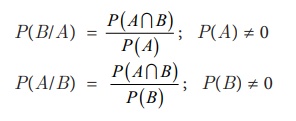
(i) Multiplication Theorem:
The
probability of the simultaneous happening of two events A and B is given by
P(A∩B) = P(A).P(B/A) or
P(A∩B) = P(B).P(A/B)
NOTE
If A and
B are two independent events then P(A
and B) = P(A∩B) = P(A)
P(B)
The
theorem can be extended to three or more independent events. Thus for three
events the theorem states that
P(A and B and C) = P (A∩B∩C) = P(A) P(B) P(C)
Example 8.24
An unbiased die is thrown. If A
is the event ‘the number appearing is a multiple of 3’ and B be the event ‘the number appearing is even’ number then find
whether A and B are independent?
Solution:
We know that the sample space is S = {1,2,3,4,5,6}
Now, A = {3,6} ; B = { 2,4,6} then (A∩B) ={6}

Clearly P(A
∩ B) = P(A) P(B)
Hence A and B are independent events.
Example 8.25
Let P(A) = 3/5 and P(B) = 1/5. Find P(A ∩ B) if A and B are independent events.
Solution:
Since A and B are independent events then P(A∩B)
= P(A) P(B)

Example 8.26
Three
coins are tossed simultaneously. Consider the events A ‘three heads or three tails’, B ‘atleast two heads’ and C ‘at most two heads’ of the pairs (A,B), (A,C) and (B,C), which are
independent? Which are dependent?
Solution:
Here the sample space of the
experiment is
S= {HHH,
HHT, HTH, HTT, THH, TTH, THT, TTT}
A =
{Three heads or Three tails} ={HHH, TTT}
B = {at
least two heads} ={HHH, HHT, HTH, THH}
And C =
{at most two heads} = {HHT, HTH, HTT, THH, TTH, THT, TTT}
Also (A∩B)
= {HHH}; (A∩C) = {TTT} and (B∩C) ={HHT, HTH, THH}
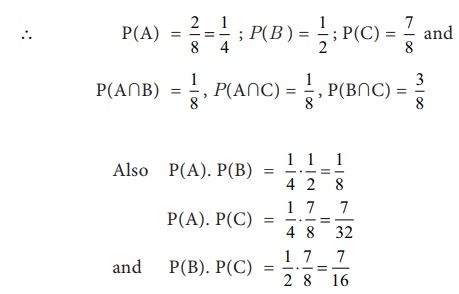
Thus,
P(A∩B) = P(A). P(B)
P(A∩C) ≠P(A) . P(C) and
P(B∩C) ≠P(B). P(C)
Hence,
the events (A and B) are independent, and the events (A and C) and (B and C) are dependent.
Example 8.27
A can
solve 90 per cent of the problems given in a book and B can solve 70 per cent. What is the probability that at least one
of them will solve a problem selected at random?
Solution:
Given the
probability that A will be able to solve the problem
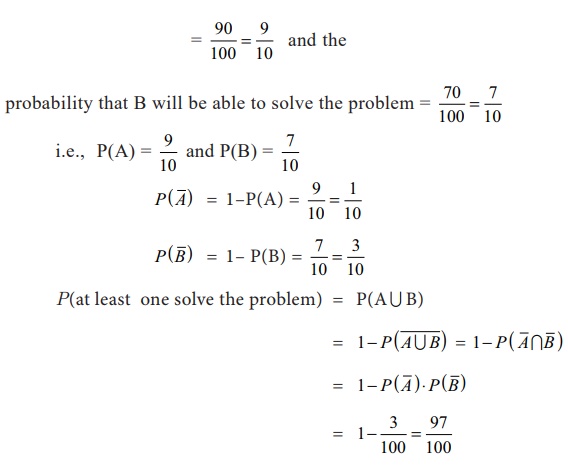
Hence the
probability that at least one of them will solve the problem = 97/100
Example 8.28
A bag contains 5 white and 3
black balls. Two balls are drawn at random one after the other without
replacement. Find the probability that both balls drawn are black.
Solution:
Let A, B
be the events of getting a black ball in the first and second draw Probability
of drawing a black ball in the first attempt is

Probability
of drawing the second black ball given that the first ball drawn is black

∴ The probability that both balls drawn are black is
given by

Example 8.29
In a
shooting test the probability of hitting the target are ¾ for A, ½ for B and
2/3 for C. If all of them fire at the
same target, calculate the probabilities that
(i) All
the three hit the target
(ii) Only
one of them hits the target
(iii) At
least one of them hits the target
Solution:
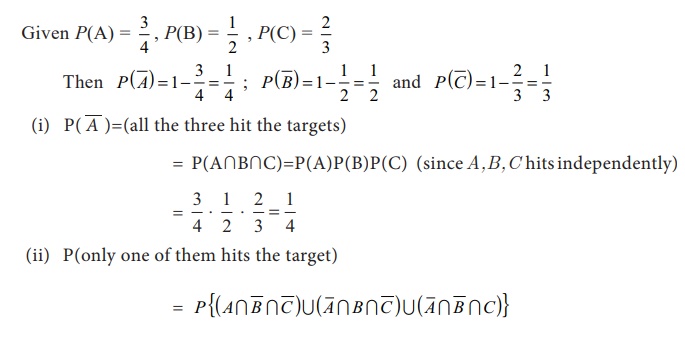
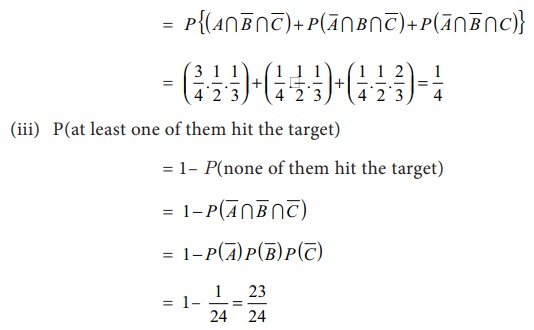
Example 8.30
Find the probability of drawing a
queen, a king and a knave (Jack) in that order from a pack of cards in three
consecutive draws, the card drawn not being replaced.
Solution :
Let
A : the
card drawn is a queen
B: the
card drawn is a king
C: the
card is drawn is a knave(jack)
P(drawing a queen card) =
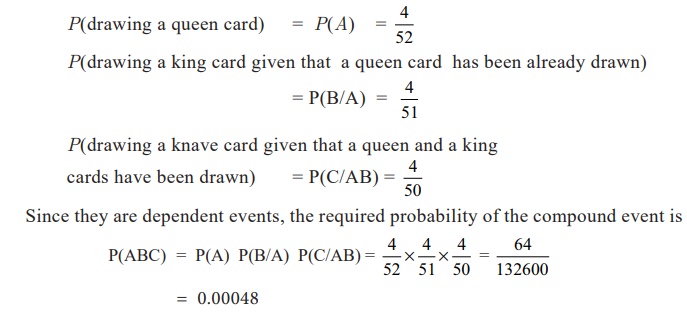
Related Topics